ITALO GISMONDI (1887-1974)
English translation of: Paola Olivanti, "Italo Gismondi", Dizionario biografico dei Soprintendenti Archeologi (1904-1974), Papadopoulos J. (ed.), Bologna 2012, 386-390.
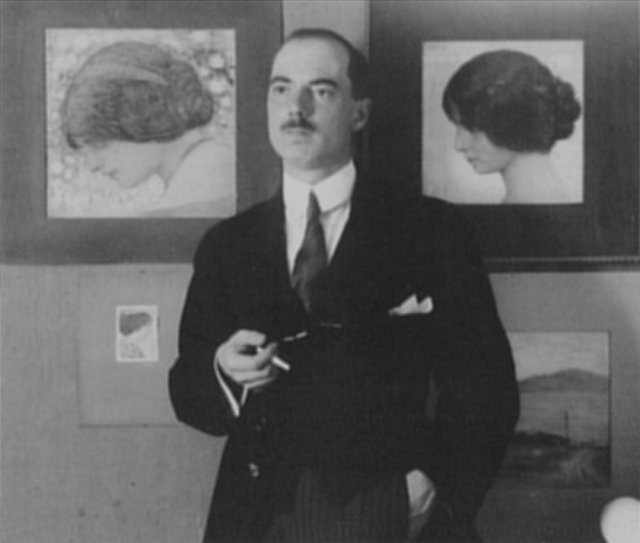
Ca. 1915-1920.
Italo Gismondi was born in Rome on August 12, 1887; he married Teresa Risi, with whom he had two daughters: Anna Maria (1919) and Gabriella (1923). After completing his training at the Royal Institute for Fine Arts, and then at the School of Architecture (which would later become the Faculty of Architecture, giving all graduates the title of architect), on May 14, 1910 he submitted the application for participation in the competition for draftsmen of the Administration of monuments, museums, galleries and excavations of antiquity organized by the Ministry of Education; the request was prepared for two locations: the Office of the Excavations of Ostia and the Superintendency of the Excavations and Archaeological Museums of Ancona. Winner of the competition, in August of the same year he was assigned to the direction of the excavations of Ostia alongside Dante Vaglieri, where he was joined the following year by Guido Calza. In Ostia Gismondi worked until 1919, except for the interruption of two years for military service, served as a soldier of the V Engineer Regiment in Turin (1916-1918).
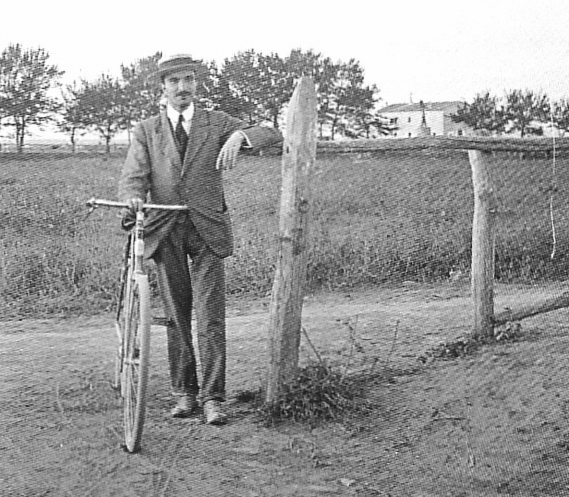
In Ostia, ca. 1911-1912.
Since his arrival in Ostia, Gismondi began to work at a fast pace, so much so that Vaglieri with a note sent to the Minister of Education (June 1913) proposed him for an extraordinary compensation of 200 lire, since Gismondi, "in foreign hours to the compulsory office ones, he worked to update the reliefs and photographs of the monuments that came to light"; he also dealt with accounting. A distinctive feature of his character was an incredible physical resistance which, especially in the workplace, did not seem to know fatigue (Motta 2007, p. 21).
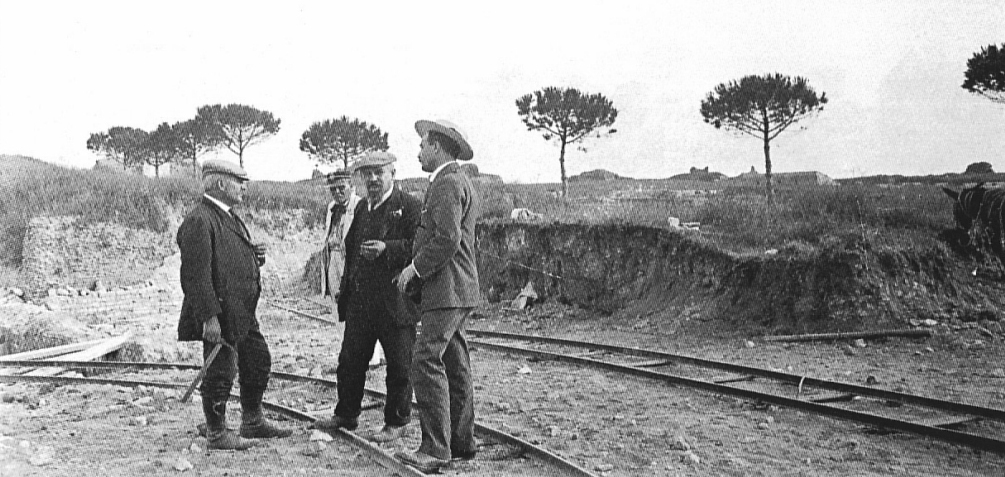
In Ostia, in Via dei Vigili, with Raffaele Finelli and Dante Vaglieri, ca. 1911-1912.
After 1919, while Roberto Paribeni was Superintendent, Gismondi was transferred to the Superintendency for Antiquities of Rome, Forum and Palatine Office, while retaining the assignment for the excavations of Ostia.
Starting from these years, and for the duration of his administration career, Gismondi found himself engaged on several fronts simultaneously, both in Italy and abroad. His work was precious, to the point of sometimes sparking not too veiled controversies between his direct superiors and the Central Administration.
Already in 1923 Guido Calza, freshly nominated to the Directorate of the Excavations of Ostia, with a note dated 29 December sent to the competent Ministry, asked for Gismondi a change of career to architect. This request, which constituted recognition for the work done in thirteen years of service, was accepted by the Ministry of Education in 1932, with the appointment of Gismondi as assistant architect and assignment to the Superintendency for Antiquities in Rome. A few years later, as a result of a career progression, Gismondi was promoted to seniority as an architect, group A, grade IX (1935), then, following a title competition, he became Director of II class (1937).
A further request to obtain the definitive assignment of Gismondi to the Ostian office is contained in two notes forwarded by Calza to the General Manager at the beginning of 1938, the year in which the excavation work began in Ostia in view of the Universal Exposition which should have been held in Rome in 1942 (E42). Despite repeated requests, justified, according to Calza, also by the fact that Luigi Crema (architect), Guido Caraffa (designer) and Guglielmo Gatti (deputy secretary) were already assigned to the Roman offices of the Superintendency, characters known for their graphic ability and for reconstructive abilities, in addition to the epigraphist Attilio Degrassi, the Superintendent Giuseppe Moretti, in a letter sent on February 21, 1938 to the General Management, asks that Gismondi not be assigned predominantly to Ostia before completing the restoration of the Ara Pacis and the consolidation of the walls of Spello, works that would have ended at the end of the Year of Augustus (1938). In fact, starting from March 1938, Gismondi was also operating in Ostia Antica "for the extraordinary works that will have to be carried out for the Universal Exposition"; as part of this assignment, he will, among other things, deal with accounting relationships with the companies assigned the lots in the contract.
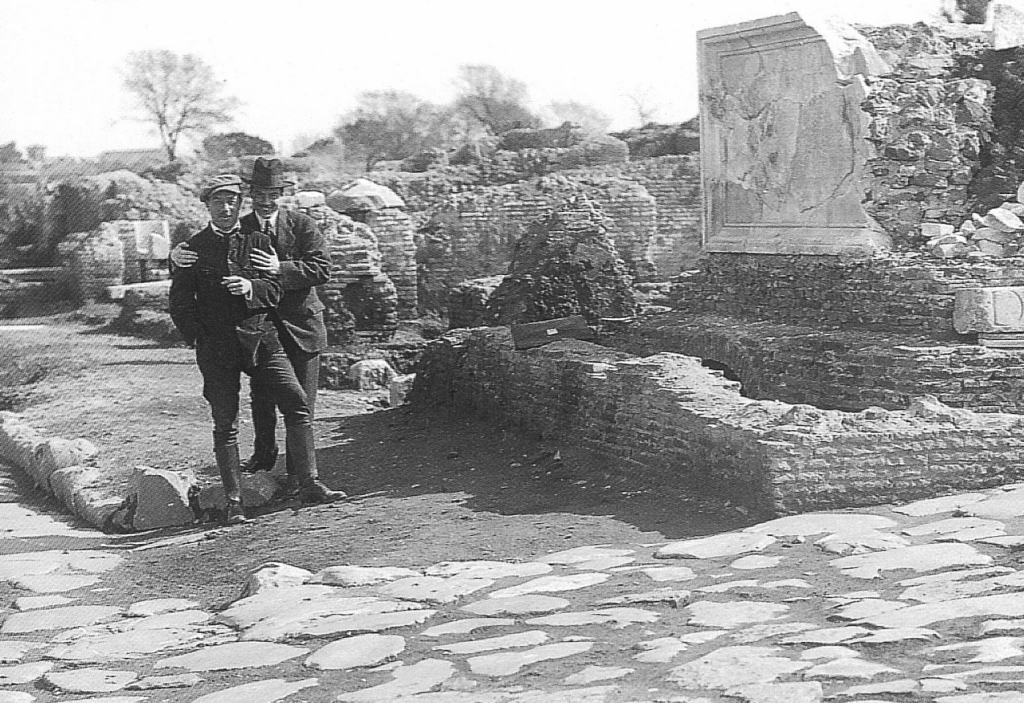
In Ostia (Via dei Sepolcri), with Guido Calza.
The definitive transfer to the Direction of the Excavations of Ostia Antica (September 25, 1938, with effect from December 1) and the commitment made by Gismondi as part of the project for the excavation of the city did not stop his superiors, who continued to contend for his time and his work: in June 1940, Gismondi was recalled (via a very urgent note and with immediate effect) to the Royal Superintendency of the Galleries of Rome I "for the work of clearing and transporting the works of art". Immediate was the reply from Calza who, in a letter sent to the Ministry (July 2, 1940), asked not to entrust other tasks to Gismondi, whose absence from Ostia (lasting 17 days) caused a delay "in the delivery of the accounting of the contracts in course of the Ostian work for the E42, which is entrusted to him". This at a time when "large-scale works are underway that require the assiduous and constant effort of the office, made up as known only by a director, an inspector and an assistant inspector". Gismondi will return to Ostia only in October.
In 1947 he was promoted to Class I Director (grade VII) and then, in the following year, II Class Superintendent (group A, grade VI).
After the intense years of the E42, which had seen him at work as a draftsman, restorer and designer, Gismondi dedicated himself to the completion of the new Ostia plan, destined to be the fulcrum of the planned publication of the excavations carried out in 1938-1942. The death of Guido Calza (1946) did not stop the project, which saw the light in 1953 thanks to the collaboration of a group of scholars who had been personally involved in those excavations: in addition to Gismondi, Giovanni Becatti, Herbert Bloch and Guglielmo De Angelis d'Ossat. Gismondi was responsible for the drafting of the chapter on Ostian masonry, where the results of his 40 years of study are summarized in a clear and accurate way.
To crown the career, with a letter from the Ministry of Education, General Management of AA.BB.AA., prot. 27562 of 15 December 1952 was entrusted to Gismondi (starting from 16 December) the direction of the Superintendency for Antiquities of Rome III, and at the same time he was invited to contact the Superintendent Romanelli for the handover. In his reply to the Minister, Gismondi assured: "I will try to carry out the task assigned to me, dedicating all my activities and experiences completely to the work of Ostia".
Placed at rest from February 1, 1954, his work was requested for several more years and the documents are still recorded in the personal file, even though he was now declared "unrelated to the State Administration".
At the beginning there was mention of Gismondi's activity not linked to Rome or Ostia and the missions in which he was called to participate, even after his retirement. In 1921 he participated in the Italian mission in Rhodes for the study of the walls of the Crusader era; from 1925 he was part of the archaeological mission to Cyrene "to take care of the excavations, the restoration and reconstruction of ancient buildings". At this juncture he found himself collaborating with Carlo Anti, professor of archeology at the University of Padua, and with Luigi Pernier, Director of the Archaeological School of Athens, as well as with Gismondi Oliverio, since 1923 Director of the Superintendency for Antiquities of Cyrenaica.
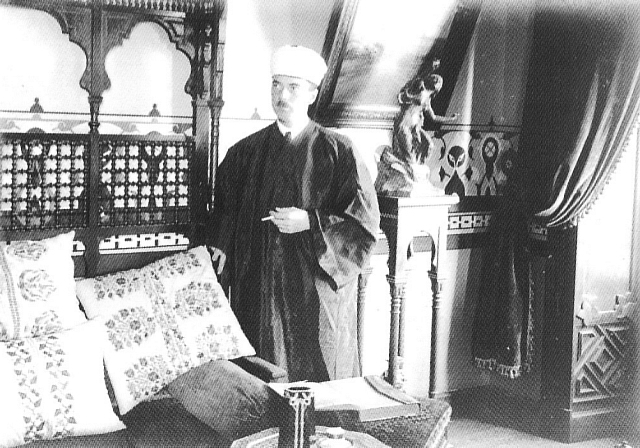
In Cyrene.
From the list of collaborations attached to the bibliography below, it is clear which and how many Italian colleagues have repeatedly requested to use Gismondi's work to document an excavation or plan a restoration. Just to mention the most important, we remember the theater of Taormina and that of Syracuse, the so-called temple of Ceres and that of Neptune in Paestum, studies on San Gemini and Carsulae, the works for the Spoleto and Pietrabbondante theaters, for some monuments in Saepinum, for the Amiternum amphitheater. Among the latest works mentioned in the personal file are the participation in the excavations of Nora, in Sardinia, and the assignment for the graphic documentation of the villa del Casale in Piazza Armerina. He also oversaw the restoration of the Planetarium (on behalf of the Istituto Luce), some parts of the Baths of Diocletian (via Cernaia side) and the Sepulcher of the Scipios (in 1926, on behalf of the Commission of History and Ancient Art of the Governorate of Rome).
Of the numerous prizes and honors with which he was awarded we remember: the Agostini competition, launched by the Insigne Congregation of Virtuosos at the Pantheon for an architectural project, which he won in March 1915; Knight of the Order of the Crown of Italy (1925); Commander of the same Order (1939); "Cultori di Roma" prize (1974), awarded by ordinary members of the Institute of Roman Studies, integrated by representatives of the Ministry of Education, the Municipality of Rome, the International Union of Institutes of Archeology and Art History in Rome and the National Academic Union.
Gismondi died in Rome on 2 December 1974.
At the request of his wife Teresa, a request supported by the Superintendency of Ostia, Gismondi was buried in the chapel of S. Ercolano, next to Dante Vaglieri and Guido Calza. On his tombstone an incised epitaph in its sobriety: "Italo Gismondi. Ostian architect".
On December 3, 1975 at 11.00 am, an honorary plaque was inaugurated at the entrance to the Museum of the Excavations of Ostia. The request, sent by the Ostian Superintendency to the Ministry for Cultural and Environmental Heritage through the then Superintendent M.L. Veloccia Rinaldi, has received the support, among others, of the Association of Italian Museums.
From the reading of the papers contained in Gismondi's personal file, both those relating to his professional activity and those related to the course of his private life, the profile of a rigorous and attentive official emerges, who has left a noteworthy trace in the administration where he served; but also of a keen and gifted scholar of great synthesis, qualities which - in the meager bibliography - have assured us pages full of notes and still fruitful ideas.
Photo credits: Ricostruire l'antico prima del virtuale. Italo Gismondi. Un architetto per l'archeologia (1887-1974), Filippi F. (ed.), Roma 2007:
- Fig. 1 on p. 12 (Fondo Gismondi, n. 36/C).
- Fig. 1 on p. 37 (SBAO, neg. 2-S40).
- Fig. 3 on p. 39 (SBAO, neg. S56).
- Fig. 2 on p. 38 (SBAO, neg. B1940).
- Fig. 2 on p. 218 (Fondo Gismondi, 38/12).